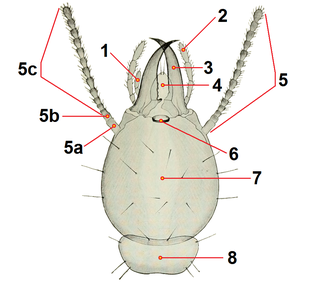
Trinervitermes trinervoides is a species of termite belonging to family Termitidae. It is native to and widespread in southern Africa where it inhabits mesic to semi-arid grasslands. Due to the snout on the head of soldiers, and their grass collecting habits, they are known as snouted harvester termites.
Neotermes greeni, is a species of drywood termite of the genus Neotermes. It is native to India and Sri Lanka. It closely resembles Postelectrotermes militaris. It is a minor pest of tea in Sri Lanka, and major pest of mango in India.

Coptotermes ceylonicus, is a species of subterranean termite of the genus Coptotermes. It is native to India and Sri Lanka. It is a common wood destroying termites, which damage to logs, woodens structures of both natural and man-made. It is a pest of many economically valuable trees such as Hevea brasiliensis and Camellia sinensis, and also an inhabitant of Anacardium occidentale, Cocos nucifera, Ficus fergusonii, Gliricidia sepium, Grevillea robusta, Madhuca longifolia, Tamarindus indica and Theobroma cacao.
Coptotermes emersoni, is a species of subterranean termite of the genus Coptotermes. It is native to India, Sri Lanka, and Vietnam. Though it is a wood destroying termite, it was first found from an electrical wire case in the National Museum of Colombo.
Coptotermes gaurii, is a species of subterranean termite of the genus Coptotermes. It is native to South India and Sri Lanka. It is a serious pest of tea in Sri Lanka.
Heterotermes ceylonicus is a species of subterranean termite of the family Rhinotermitidae. It is native to India and Sri Lanka. It is a wood destroying termites, which damage to logs, wooden structures of both natural and man-made such as tree stumps of Gravellia and Hevea brasiliensis, and tea plantations. It can be also found in mounds of Hypotermes obscuriceps.
Heterotermes indicola, is a species of subterranean termite of the genus Heterotermes. It is native to tropical India, Pakistan and Sri Lanka but has extended its range into the subtropics and warm temperate areas of the Himalayan foothills to altitudes of about 2,000 m (6,600 ft). It causes damage to timber in buildings and is one of the most destructive termites in urban and agricultural areas in the world. Soldiers are about 4.1-4.9mm long. Extracts of garlic and Calotropis procera are known to have termiticidal effects on H. indicola.
Prorhinotermes flavus is a species of subterranean termite of the genus Prorhinotermes. It is native to India, Sri Lanka, Andaman Islands and Nicobar Islands. It is found in coastal areas such as mangroves. It shows both dampwood and subterranean termite behavior, nesting in dead trees but foraging on soil as a typical subterranean termite. It is not known to be a pest.
Macrotermes convulsionarius is a species of termite of the family Termitidae. It is native to India and Sri Lanka. Soldiers are very large with well developed mandibles. It is a major pest of many wood works in buildings. Flagellated bacteria such as Bacillus, Acinitobacter, Salmonella, Enterobacter, and Enterococcus are found abundant in gut of M. convulsionarius.
The sugarcane termite is a species of termite of the genus Odontotermes. It is native to India and Sri Lanka. It is recorded from coconut palms and is a pest of sugarcane.
Odontotermes ceylonicus, is a species of termite of the genus Odontotermes. It is native to India and Sri Lanka. Though nests in the ground, they never construct termitaria. It attacks many dead, diseased rotten plant roots and wooden buildings. It is a major pest of sugarcane and a secondary pest of tea.

Odontotermes horni, is a species of termite of the genus Odontotermes. It is native to India and Sri Lanka. It attacks many dead, decaying trees and fertilized soil. Though nests on ground, they do not construct a termitaria. It is a pest of tea, coconut and sugarcane.
Odontotermes redemanni, is a species of termite of the genus Odontotermes. It is native to India and Sri Lanka. It damages wooden constructions. It is a pest of sugarcane, tea and coconut. They construct termitaria during November to March when rainfall and ambient temperature become low. Underground termite nests of this species are a natural host for the important Traditional Chinese Medicine fungus Xylaria nigripes, also known as Wu Ling Shen.
Microtermes obesi, the wheat termite, is a small species of termite of the genus Microtermes. It is native to India, Sri Lanka, Pakistan and Vietnam. It is a major pest of wheat and minor pest of sugarcane.
Trinervitermes rubidus, is a species of mound building termite of the genus Trinervitermes. It is native to Sri Lanka.
Dicuspiditermes nemorosus, is a species of small termite of the genus Dicuspiditermes. It is found in Sri Lanka, India, Malaysia and Borneo. The species is known to build three different types of mounding nests, where two termitaria have single protruding nest structure and third nest type is typified by several protruding nest all connected at the base.

Trinervitermes is a termite genus belonging to family Termitidae. Members are native to the Old World. They inhabit grasslands and store grass in their nests or mounds, just below the ground surface. Their grass-collecting activities are mainly nocturnal. The soldier caste has atrophied mandibles and a fontanelle squirt gun on the frons. Diterpenes and monoterpenes are released to deter ants and smaller predators, but these are not effective against larger mammalian predators. Due to the snout on the head of soldiers and their grass-collecting habits, they are known as snouted harvester termites.

Odontotermes is a termite genus belonging to subfamily Macrotermitinae, which is native to the Old World. They are most destructive in wooden homes, and are agricultural pests in the tropics and subtropics of Africa and Asia. It is the most diverse termite genus in Africa, with 78 species recorded.

Acanthaspis quinquespinosa is a species of assassin bug found in India, Sri Lanka, Myanmar, Nepal and Tibet. It is a predator, and both nymphs and adults feed on termites, beetles, caterpillars and other insect prey.




